2014 NISSAN TEANA charging
[x] Cancel search: chargingPage 3435 of 4801
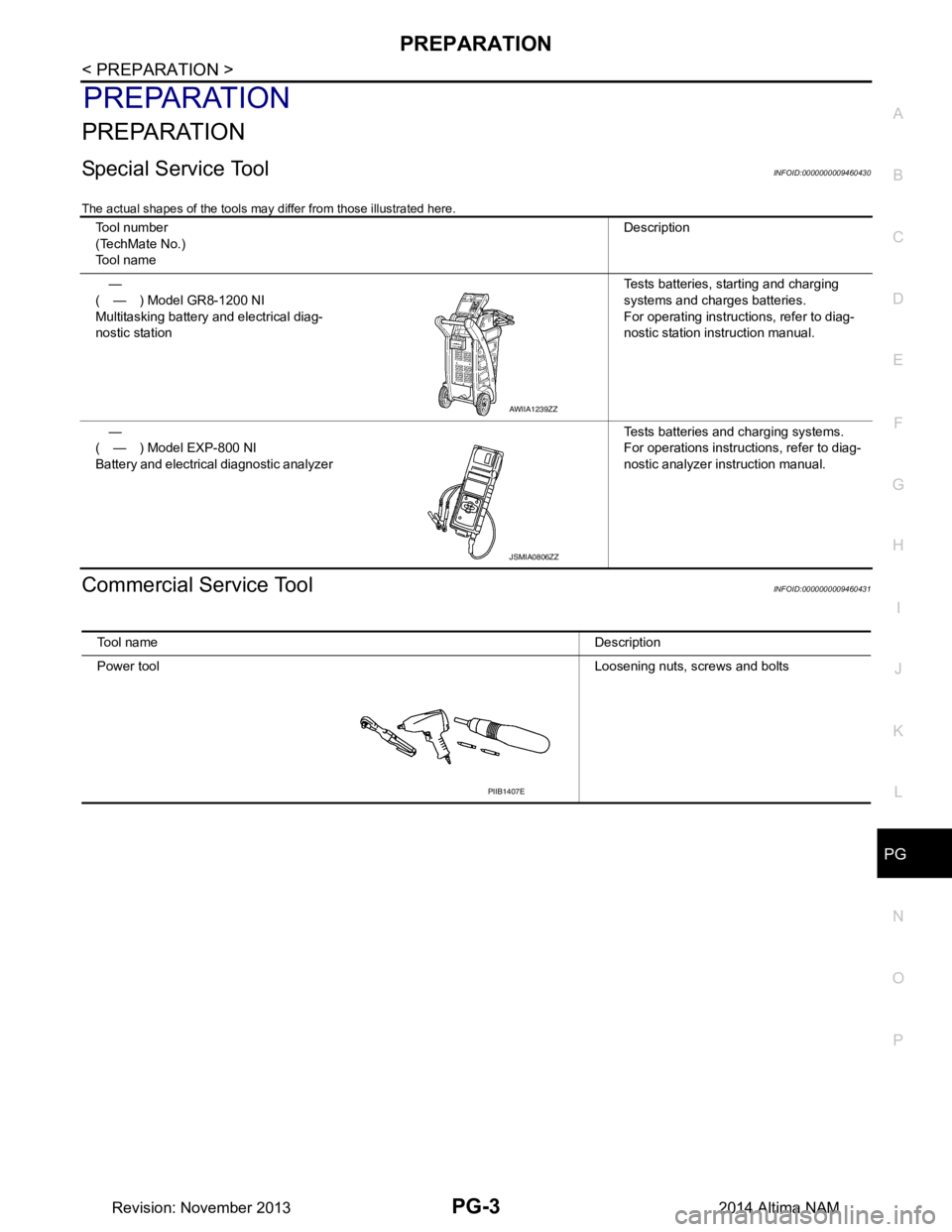
PG
PREPARATIONPG-3
< PREPARATION >
C
D E
F
G H
I
J
K L
B
A
O P
N
PREPARATION
PREPARATION
Special Service ToolINFOID:0000000009460430
The actual shapes of the tools may differ from those illustrated here.
Commercial Service ToolINFOID:0000000009460431
Tool number
(TechMate No.)
Tool name Description
—
( — ) Model GR8-1200 NI
Multitasking battery and electrical diag-
nostic station Tests batteries, starting and charging
systems and charges batteries.
For operating instruct ions, refer to diag-
nostic station instruction manual.
—
( — ) Model EXP-800 NI
Battery and electrical diagnostic analyzer Tests batteries and charging systems.
For operations instructions, refer to diag-
nostic analyzer instruction manual.
AWIIA1239ZZ
JSMIA0806ZZ
Tool name Description
Power tool Loosening nuts, screws and bolts
PIIB1407E
Revision: November 20132014 Altima NAM
Page 3436 of 4801
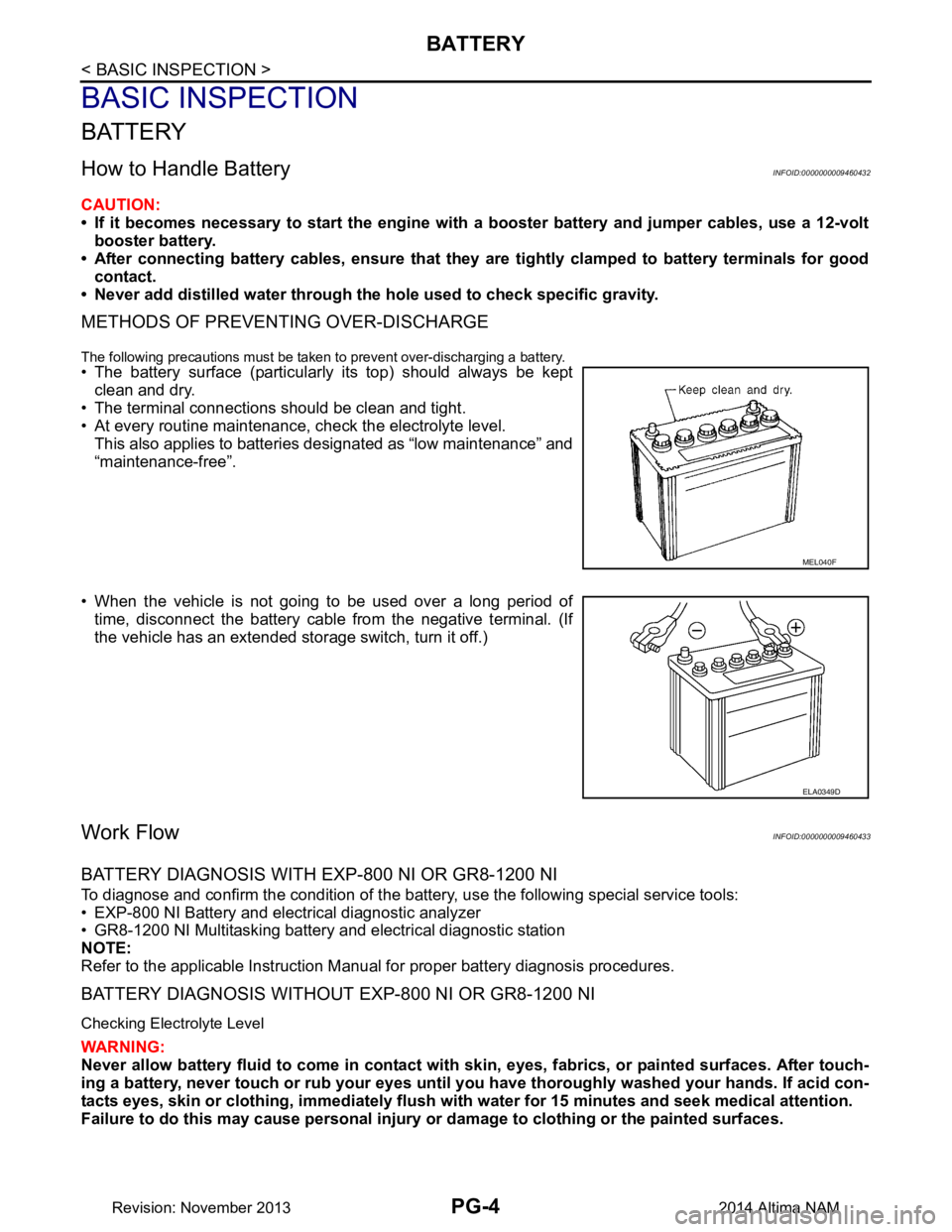
PG-4
< BASIC INSPECTION >
BATTERY
BASIC INSPECTION
BATTERY
How to Handle BatteryINFOID:0000000009460432
CAUTION:
• If it becomes necessary to start the engine with a booster battery and jumper cables, use a 12-volt
booster battery.
• After connecting battery cables, ensure that they are tightly clamped to battery terminals for good
contact.
• Never add distilled water through the hole used to check specific gravity.
METHODS OF PREVENTING OVER-DISCHARGE
The following precautions must be taken to prevent over-discharging a battery.
• The battery surface (particularly its top) should always be kept
clean and dry.
• The terminal connections should be clean and tight.
• At every routine maintenance, check the electrolyte level. This also applies to batteries designated as “low maintenance” and
“maintenance-free”.
• When the vehicle is not going to be used over a long period of time, disconnect the battery cable from the negative terminal. (If
the vehicle has an extended storage switch, turn it off.)
Work FlowINFOID:0000000009460433
BATTERY DIAGNOSIS WITH EXP-800 NI OR GR8-1200 NI
To diagnose and confirm the condition of the batte ry, use the following special service tools:
• EXP-800 NI Battery and electrical diagnostic analyzer
• GR8-1200 NI Multitasking battery and electrical diagnostic station
NOTE:
Refer to the applicable Instruction Manual for proper battery diagnosis procedures.
BATTERY DIAGNOSIS WITHOUT EXP-800 NI OR GR8-1200 NI
Checking Electrolyte Level
WARNING:
Never allow battery fluid to come in contact with skin, eyes, fabrics, or painted surfaces. After touch-
ing a battery, never touch or rub your eyes until you have thoroughly washed your hands. If acid con-
tacts eyes, skin or clothing, immediately flush wit h water for 15 minutes and seek medical attention.
Failure to do this may cause personal injury or damage to clothing or the painted surfaces.
MEL040F
ELA0349D
Revision: November 20132014 Altima NAM
Page 3437 of 4801
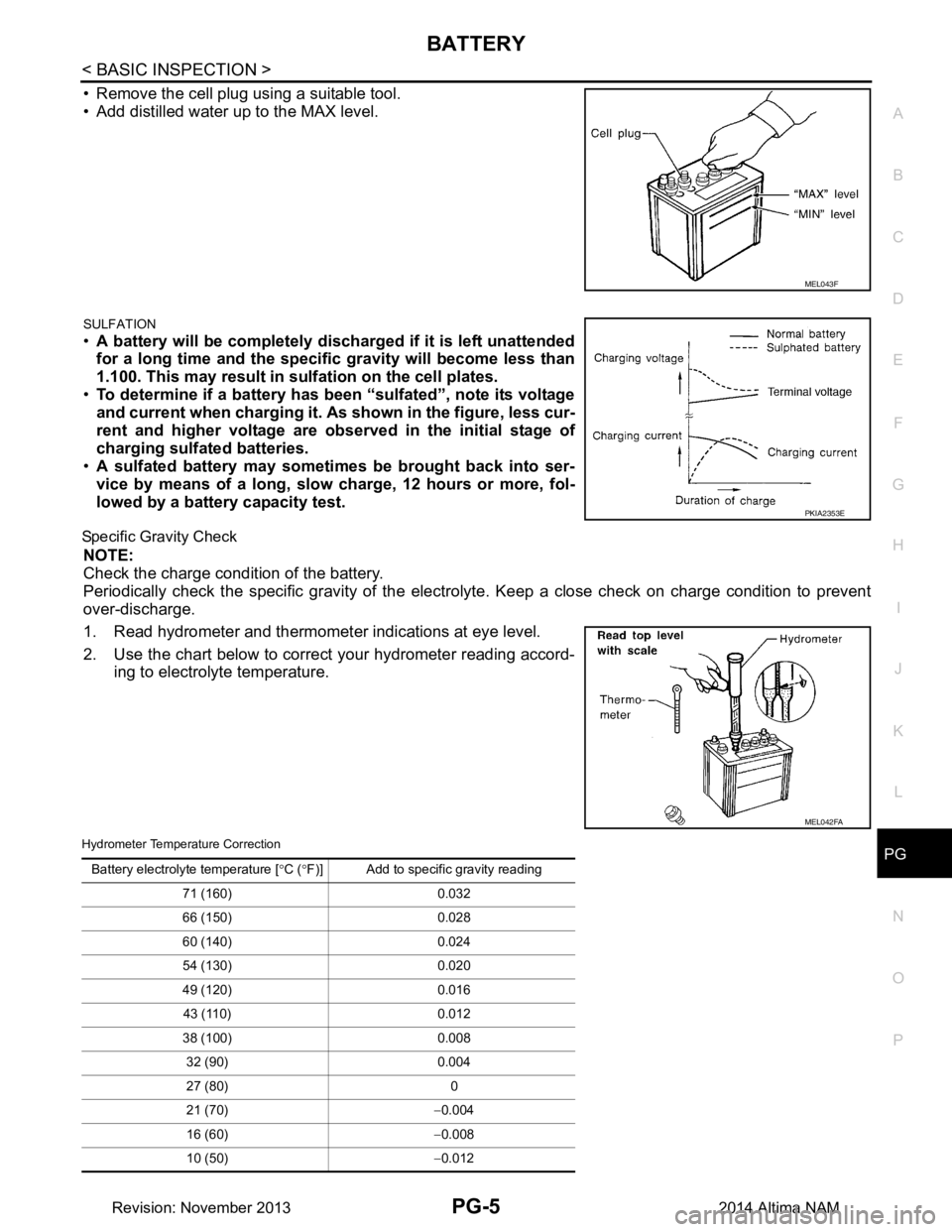
PG
BATTERYPG-5
< BASIC INSPECTION >
C
D E
F
G H
I
J
K L
B
A
O P
N
• Remove the cell plug using a suitable tool.
• Add distilled water up to the MAX level.
SULFATION
• A battery will be completely discharged if it is left unattended
for a long time and the specifi c gravity will become less than
1.100. This may result in sulfation on the cell plates.
• To determine if a battery has been “sulfated”, note its voltage
and current when charging it. As shown in the figure, less cur-
rent and higher voltage are ob served in the initial stage of
charging sulfated batteries.
• A sulfated battery may sometimes be brought back into ser-
vice by means of a long, slow charge, 12 hours or more, fol-
lowed by a battery capacity test.
Specific Gravity Check
NOTE:
Check the charge condition of the battery.
Periodically check the specific gravity of the electr olyte. Keep a close check on charge condition to prevent
over-discharge.
1. Read hydrometer and thermometer indications at eye level.
2. Use the chart below to correct your hydrometer reading accord- ing to electrolyte temperature.
Hydrometer Temperature Correction
MEL043F
PKIA2353E
MEL042FA
Battery electrolyte temperature [ °C ( °F)] Add to specific gravity reading
71 (160) 0.032
66 (150) 0.028
60 (140) 0.024
54 (130) 0.020
49 (120) 0.016 43 (110) 0.012
38 (100) 0.008 32 (90) 0.004
27 (80) 0
21 (70) −0.004
16 (60) −0.008
10 (50) −0.012
Revision: November 20132014 Altima NAM
Page 3438 of 4801

PG-6
< BASIC INSPECTION >
BATTERY
Charging The Battery
CAUTION:
• Never “quick charge” a fully discharged battery.
• Keep the battery away from open flame while it is being charged.
• When connecting the charger, connect the leads first, then turn on the charger. Never turn on the
charger first, as this may cause a spark.
• If battery electrolyte temperature rises above 55 °C (131 °F), stop charging. Always charge battery at
a temperature below 55 °C (131 °F).
Charging Rates (Standard Charge)
Charging Rates (Quick Charge)
NOTE:
The ammeter reading on your battery charger will automat ically decrease as the battery charges. This indi-
cates that the voltage of the battery is increasing norma lly as the state of charge improves. The charging amps
indicated above refer to initial charge rate.
• If, after charging, the specific gravity of any two ce lls varies more than 0.050, the battery should be replaced.
4 (40)−0.016
− 1 (30) −0.020
− 7 (20) −0.024
− 12 (10) −0.028
− 18 (0) −0.032
Battery electrolyte temperature [
°C ( °F)] Add to specific gravity reading
Corrected specific gravity Approximate charge condition
1.260 - 1.280 Fully charged
1.230 - 1.250 3/4 charged
1.200 - 1.220 1/2 charged
1.170 - 1.190 1/4 charged
1.140 - 1.160 Almost discharged 1.110 - 1.130 Completely discharged
Approximate charge condi- tion Charge current (A) Charge time (h)
Fully charged
72
3/4 charged 2.5
1/2 charged 5
1/4 charged 7.5
Almost discharged 9
Completely discharged 10
Approximate charge condi- tion Charge current (A) Charge time (h)
Fully charged — — 3/4 charged 16
0.5
1/2 charged
33
1/4 charged
Almost discharged
Completely discharged — —
Revision: November 20132014 Altima NAM
Page 4193 of 4801
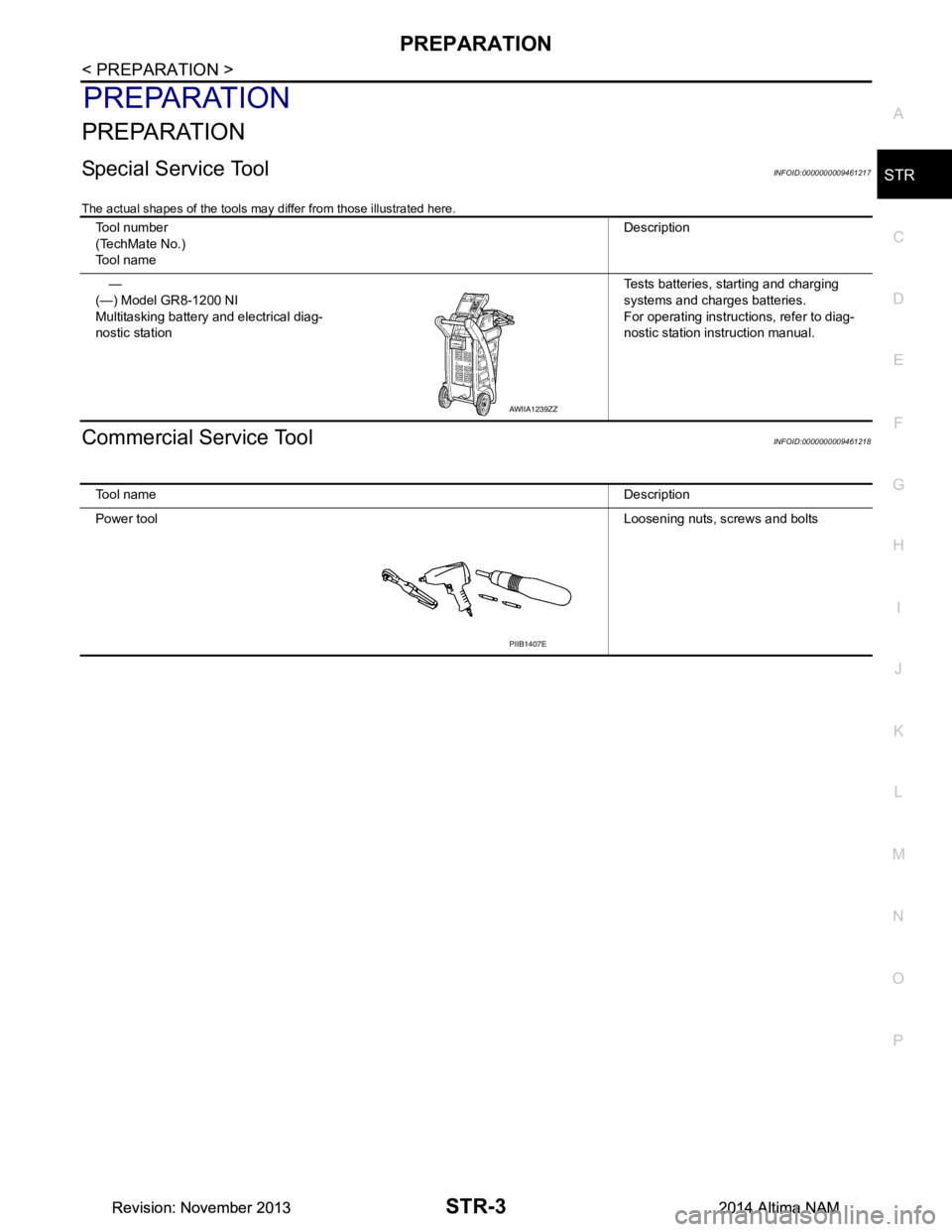
PREPARATIONSTR-3
< PREPARATION >
C
D E
F
G H
I
J
K L
M A
STR
NP
O
PREPARATION
PREPARATION
Special Service ToolINFOID:0000000009461217
The actual shapes of the tools may differ from those illustrated here.
Commercial Service ToolINFOID:0000000009461218
Tool number
(TechMate No.)
Tool name Description
—
(—) Model GR8-1200 NI
Multitasking battery and electrical diag-
nostic station Tests batteries, starting and charging
systems and charges batteries.
For operating instruct ions, refer to diag-
nostic station instruction manual.
AWIIA1239ZZ
Tool name Description
Power tool Loosening nuts, screws and bolts
PIIB1407E
Revision: November 20132014 Altima NAMRevision: November 20132014 Altima NAM
Page 4204 of 4801
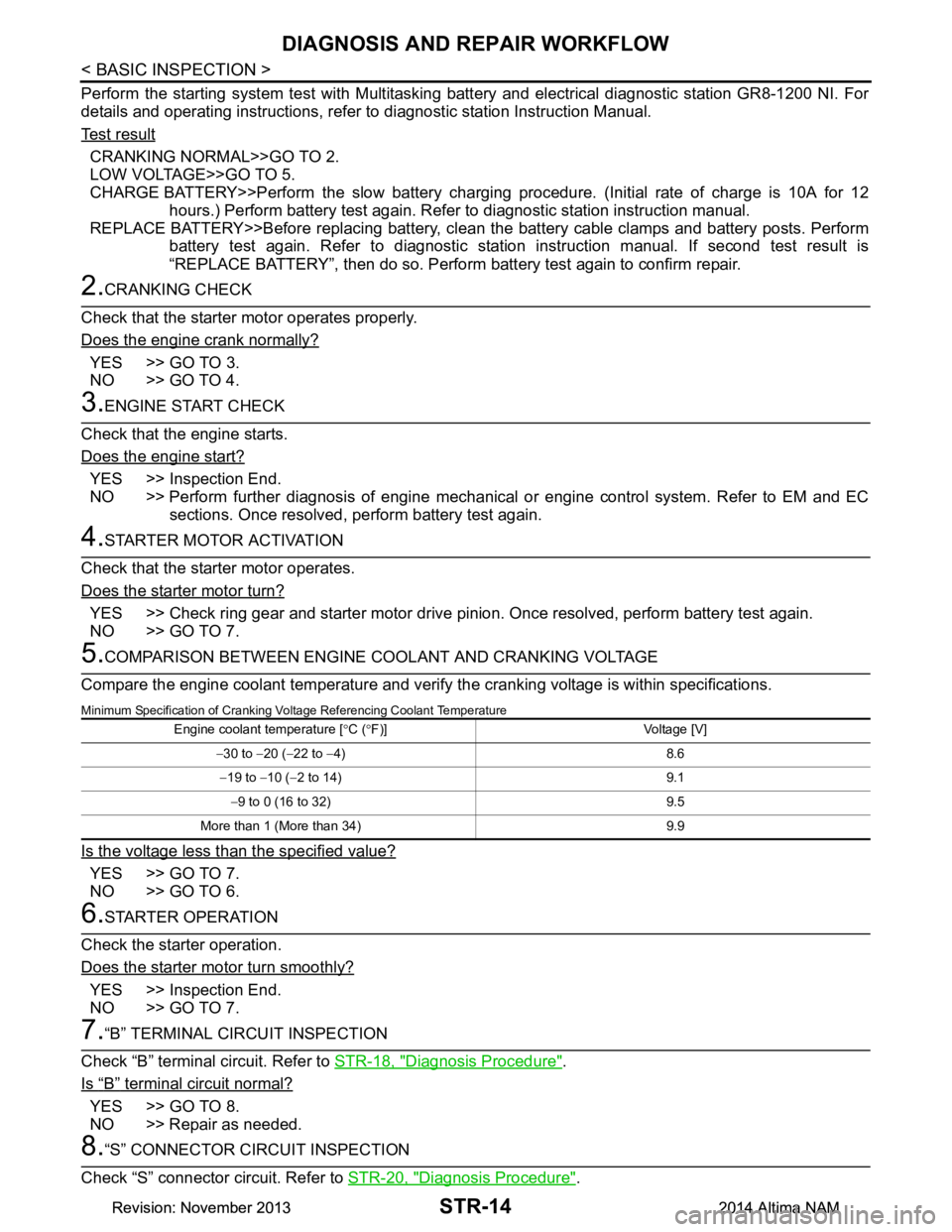
STR-14
< BASIC INSPECTION >
DIAGNOSIS AND REPAIR WORKFLOW
Perform the starting system test with Multitasking battery and electrical diagnostic station GR8-1200 NI. For
details and operating instructions, refer to diagnostic station Instruction Manual.
Te s t r e s u l t
CRANKING NORMAL>>GO TO 2.
LOW VOLTAGE>>GO TO 5.
CHARGE BATTERY>>Perform the slow battery charging procedure. (Initial rate of charge is 10A for 12
hours.) Perform battery test again. Refer to diagnostic station instruction manual.
REPLACE BATTERY>>Before replacing battery, clean t he battery cable clamps and battery posts. Perform
battery test again. Refer to diagnostic station instruction manual. If second test result is
“REPLACE BATTERY”, then do so. Perform battery test again to confirm repair.
2.CRANKING CHECK
Check that the starter motor operates properly.
Does the engine crank normally?
YES >> GO TO 3.
NO >> GO TO 4.
3.ENGINE START CHECK
Check that the engine starts.
Does the engine start?
YES >> Inspection End.
NO >> Perform further diagnosis of engine mechanical or engine control system. Refer to EM and EC sections. Once resolved, perform battery test again.
4.STARTER MOTOR ACTIVATION
Check that the starter motor operates.
Does the starter motor turn?
YES >> Check ring gear and starter motor drive pinion. Once resolved, perform battery test again.
NO >> GO TO 7.
5.COMPARISON BETWEEN ENGINE COOLANT AND CRANKING VOLTAGE
Compare the engine coolant temperature and verify the cranking voltage is within specifications.
Minimum Specification of Cranking Voltage Referencing Coolant Temperature
Is the voltage less than the specified value?
YES >> GO TO 7.
NO >> GO TO 6.
6.STARTER OPERATION
Check the starter operation.
Does the starter motor turn smoothly?
YES >> Inspection End.
NO >> GO TO 7.
7.“B” TERMINAL CIRCUIT INSPECTION
Check “B” terminal circuit. Refer to STR-18, "Diagnosis Procedure"
.
Is
“B” terminal circuit normal?
YES >> GO TO 8.
NO >> Repair as needed.
8.“S” CONNECTOR CIRCUIT INSPECTION
Check “S” connector circuit. Refer to STR-20, "Diagnosis Procedure"
.
Engine coolant temperature [°C ( °F)] Voltage [V]
− 30 to −20 ( −22 to −4) 8.6
− 19 to −10 ( −2 to 14) 9.1
− 9 to 0 (16 to 32) 9.5
More than 1 (More than 34) 9.9
Revision: November 20132014 Altima NAMRevision: November 20132014 Altima NAM
Page 4228 of 4801
![NISSAN TEANA 2014 Service Manual
PREPARATIONTM-13
< PREPARATION > [CVT: RE0F10D]
C
EF
G H
I
J
K L
M A
B
TM
N
O P
PREPARATION
PREPARATION
Special Service ToolsINFOID:0000000009463960
The actual shape of the tools may di ffer from th NISSAN TEANA 2014 Service Manual
PREPARATIONTM-13
< PREPARATION > [CVT: RE0F10D]
C
EF
G H
I
J
K L
M A
B
TM
N
O P
PREPARATION
PREPARATION
Special Service ToolsINFOID:0000000009463960
The actual shape of the tools may di ffer from th](/manual-img/5/57390/w960_57390-4227.png)
PREPARATIONTM-13
< PREPARATION > [CVT: RE0F10D]
C
EF
G H
I
J
K L
M A
B
TM
N
O P
PREPARATION
PREPARATION
Special Service ToolsINFOID:0000000009463960
The actual shape of the tools may di ffer from those illustrated here.
*: The O-ring as a unit part is set as a SST.
Commercial Service ToolsINFOID:0000000009463961
Tool number
(TechMate No.)
Tool name Description
1. KV311039S0 Charging pipe set
2. KV31103920* O-ring CVT fluid changing and adjustment
KV38107900
Protector
a: 32 mm dia. Installing drive shaft
JSDIA1844ZZ
PDIA1183J
Tool number
Tool name Description
Power tool Loosening nuts, screws and bolts
Drift
a: 56 mm (2.20 in) dia.
b: 50 mm (1.97 in) dia. Installing differential side oil seal
Drift
a: 65 mm (2.56 in) dia.
b: 60 mm (2.36 in) dia. Installing converter housing oil seal
PIIB1407E
NT115
NT115
Revision: November 20132014 Altima NAMRevision: November 20132014 Altima NAM
Page 4298 of 4801
![NISSAN TEANA 2014 Service Manual
CVT FLUIDTM-83
< BASIC INSPECTION > [CVT: RE0F10D]
C
EF
G H
I
J
K L
M A
B
TM
N
O P
CVT FLUID
ReplacementINFOID:0000000009464014
CAUTION:
• Always use shop paper. Never use shop cloth.
• Replac NISSAN TEANA 2014 Service Manual
CVT FLUIDTM-83
< BASIC INSPECTION > [CVT: RE0F10D]
C
EF
G H
I
J
K L
M A
B
TM
N
O P
CVT FLUID
ReplacementINFOID:0000000009464014
CAUTION:
• Always use shop paper. Never use shop cloth.
• Replac](/manual-img/5/57390/w960_57390-4297.png)
CVT FLUIDTM-83
< BASIC INSPECTION > [CVT: RE0F10D]
C
EF
G H
I
J
K L
M A
B
TM
N
O P
CVT FLUID
ReplacementINFOID:0000000009464014
CAUTION:
• Always use shop paper. Never use shop cloth.
• Replace a drain plug gasket with new ones at the fi nal stage of the operation when installing.
• Use caution when looking into the drain hole as there is a risk of dripping fluid entering the eye.
• After replacement, always pe rform CVT fluid leakage check.
1. Select “Data Monitor” in “TRANSMISSION” using CONSULT.
2. Select “FLUID TEMP” and confirm t hat the CVT fluid temperature is 40°C (104 °F) or less.
3. Check that the selector lever is in the “P ” position, then completely engage the parking brake.
4. Lift up the vehicle.
5. Remove the drain plug and drain the CVT fluid from the oil pan. Refer to TM-186, "Exploded View"
.
6. Install the drain plug to oil pan. CAUTION:
Drain plug gasket use the old one.
7. Remove the overflow plug from converter housing.
8. Install the charging pipe set (KV311039S0) (A) into the overflow plug hole.
CAUTION:
Tighten the charging pipe by hand.
9. Install the ATF changer hose (B) to the charging pipe. CAUTION:
Press the ATF changer hose all the way onto the charging
pipe until it stops.
10. Fill approximately 3 liter (2-5 /8 lmp qt) of the CVT fluid.
11. Remove the ATF changer hose and charging pipe, then install the overflow plug.
NOTE:
Perform this work quickly because CVT fluid leaks.
12. Lift down the vehicle.
13. Start the engine.
14. While depressing the brake pedal, shift the selector leve r to the entire position from “P” to “DS”, and shift it
to the “P” position.
NOTE:
Hold the lever at each position for 5 seconds.
15. Check that the CONSULT “Data Monitor” in “FLUID TEMP” is 35°C (95 °F) to 45 °C (113 °F).
16. Stop the engine.
17. Lift up the vehicle.
18. Remove the drain plug, and then drain CVT fluid from oil pan. CVT fluid : Refer to
TM-212, "General Specification"
.
Fluid capacity : Refer to TM-212, "General Specification"
.
JSDIA3714ZZ
JSDIA3713ZZ
Revision: November 20132014 Altima NAMRevision: November 20132014 Altima NAM